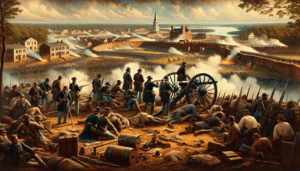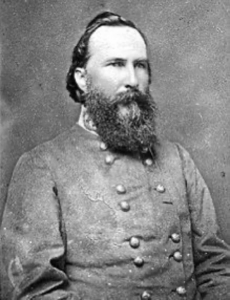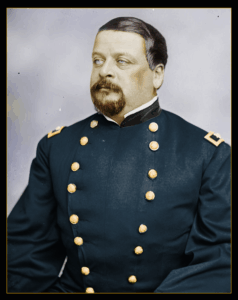A BGES Civil War Field University Program
with Brian Steel Wills
April 23–26, 2026; from Suffolk, VA


James Longstreet’s 1863 Suffolk Campaign uncovered the serious logistical challenges the Army of Northern Virginia experienced in 1863 and the desperate attempt to resolve them. The absence of his combat-tested veterans under John Bell Hood and George Pickett at Suffolk forced Gen. Robert E. Lee to improvise at Chancellorsville but proved essential to the ability of the army to operate actively in the following Gettysburg Campaign. The “Siege of Suffolk” featured critical illustrations of valor and distinction, resulting in multiple Medals of Honor, and showcased the grueling realities of trench warfare, civilian tragedy, complex army-navy cooperation, and leadership lessons that resonate to this day.
By the spring of 1863, several realities were apparent to anyone observing the progress of the Civil War. Despite nearly two years of increasingly bloody combat, the conflict showed no signs of abating. The winter of 1862–63 had proved especially difficult, particularly in central Virginia. Food supplies were scarce, and inflationary prices plagued the Confederate capital of Richmond, where a disgruntled citizenry staged a bread riot that required the intervention of the mayor, the governor, and the president of the Confederacy to suppress. Gen. Robert E. Lee, commanding the Army of Northern Virginia, took extraordinary measures to disperse his animals so they could be adequately fed for the coming campaign season. He also directed some of his best fighting officers and men, under Lt. Gen. James Longstreet, to move into southeastern Virginia and northeastern North Carolina to secure food and forage.
The target of Longstreet’s campaign was Suffolk, the small county seat of Nansemond County, Virginia, which had fallen under Union control following the Confederate evacuation in May 1862. Southern lines subsequently shifted to the Blackwater River, where limited crossing points and swampy morasses characterized the defenses. With Union troops under Maj. Gen. John James Peck, engineers constructed an extensive line of fortifications and defensive works. Cavalry patrols between Suffolk and the Blackwater operated regularly to ensure security and monitor Confederate movements.
The largest prelude to the 1863 campaign occurred on January 31, when Union forces clashed with Brig. Gen. Roger Atkinson Pryor’s Confederates at Kelly’s Store, also known as the Battle of Deserted House. The next critical action would be Longstreet’s Suffolk Campaign, which opened with heavy reconnaissance fighting on April 11. Marked largely by repeated skirmishes and steady exchanges of fire along the Nansemond River, the most deadly encounters came from sharpshooters on both sides.
Union naval assets and Confederate forces engaged in a challenging series of operations culminating in the dramatic capture of the Southern position at Hill’s Point (Fort Huger), where Capt. Hazard Stevens earned the Medal of Honor for his leadership. Previous river engagements had already brought similar recognition to four others as Union gunboats supported Peck’s defenses and the Confederates sought to seal off the Nansemond River and compel surrender.
For the Confederates, the “Siege of Suffolk” allowed commissary and quartermaster agents to scour the surrounding countryside and eastern North Carolina for desperately needed supplies. One Texan soldier rejoiced, “We just swim in bacon!” Yet despite early success, determined efforts by Union naval commanders and Maj. Gen. George Washington Getty soon limited—and ultimately thwarted—Longstreet’s objectives. As Lee and Hooker clashed at Chancellorsville, Lee’s “Old War Horse” recalled his wagons and withdrew to rejoin the Army of Northern Virginia, though he arrived only after the battle had ended. Union forces evacuated Suffolk, establishing new defensive lines closer to Portsmouth and Norfolk on July 3, 1863.
Join BGES for this exceptional program as Dr. Brian Steel Wills leads three days of exploration of this often-overlooked campaign—the most detailed study of the Siege of Suffolk offered by any organization.


Itinerary
Thursday April 23, 2026 – Orientation (6–7 p.m.)
We’ll gather at the headquarters hotel for an evening orientation with Dr. Wills. He will introduce the campaign, distribute program materials, and set the stage for our field study.
Dinner is on your own.
Friday, April 24, 2026 (8:30 a.m.–5 p.m.)
At 8:30 a.m., we begin at Riddick’s Folly, the iconic Greek Revival home of the Nathaniel Riddick family and later headquarters for Maj. Gen. John J. Peck during the Union occupation. One upper-floor room still bears Union graffiti and a prominent bloodstain from wounded troops treated there.
From Riddick’s Folly, we travel to River Point, a remnant of Suffolk’s vast complex of earthworks. The overlook across the Nansemond River faces the site of the heavy May 3 fighting that produced the campaign’s heaviest casualties.
We proceed to Franklin, a vital gateway along the Blackwater River Line established after the Confederate evacuation of Suffolk. Franklin served as a supply hub for Longstreet’s operations and a depot for goods gathered from eastern North Carolina and surrounding Virginia counties.
Next, we visit Deserted House Battlefield, where open fields and wood lots constitute the clash between Roger Pryor’s Confederates and Michael Corcoran’s Federals. A brick house now occupies the site of Kelly’s Store, the “Deserted House.”
Back to our hotel.
Lunch is included, but dinner is on your own.
Saturday, April 25, 2026 (8:30 a.m.–5 p.m.)
At 8:30 a.m., we depart to examine another portion of the Blackwater Line, visiting key points such as Ivor, Zuni, and Windsor, each significant to the campaign. Zuni featured one of the few viable river crossings, providing a direct link to Ivor and the active railroad that supported Longstreet’s advance.
We continue to Providence Methodist Church, located along the road from Suffolk to Windsor. Nestled in the woods, the church served as an outpost for Union cavalry vedettes and later as a Confederate hospital once Longstreet arrived.
Next, we visit the George Robinson Smith Home Site, where Judith Kilby Smith tragically perished while fleeing the fighting on April 13, 1863.
We end our day at Cedar Hill Cemetery, the final resting place of many prominent Suffolk citizens, including Judith Kilby Smith. The cemetery’s Confederate monument and interpretive signage commemorate the “Siege of Suffolk.”
Back to our hotel.
Lunch is included, but dinner is on your own.
Sunday, April 26, 2026 (8:30 a.m.–5 p.m.)
Departing at 8:30 a.m., we devote our final day to exploring Suffolk’s defenses—examining both the strategic and tactical outcomes of the campaign. Our tour culminates at Hill’s Point (Fort Huger), located on the grounds of the old Roundtree Dairy Farm. From an overlook, we’ll view the key site of the campaign’s most decisive action.
Return to the hotel by 5 p.m.
Lunch is included.
About the Faculty

Brian Steel Wills is the former director of the Center for the Study of the Civil War Era and professor emeritus of History at Kennesaw State University in Kennesaw, Georgia. He is the award-winning author of numerous Civil War works, including biographies of Confederate Gens. Nathan Bedford Forrest and William Dorsey Pender and Union Gen. George Henry Thomas. A native of Suffolk, Virginia—where he grew up on a peanut farm—Brian earned degrees from the University of Richmond and the University of Georgia. He now resides in Wise, Virginia, spending time on his farm with some of his four children and seven grandchildren.
Hotel Information
This program will be headquartered at the Courtyard by Marriott Suffolk Chesapeake, 8060 Harbor View Blvd., Suffolk, VA 23435 (757-483-5777). The BGES special hotel rate is $129 plus tax, with a rate cutoff date of March 24, 2026. When you call the hotel, be sure to tell them that you are booking your room with the group “Blue and Gray Education” to get the special rate.
Book your stay online with the Blue and Gray Education special rate already applied:
Book your group rate for Blue & Gray Education
Transportation
The servicing airport is Norfolk International Airport (ORF). It is 27 miles from Courtyard by Marriott, Suffolk, VA. The Hotel does not provide a shuttle. It will require a rental car, uber or taxi to reach the hotel. [Yellow Cab current rate to/from hotel-airport is $55 (757-399-3077)].
Recommended Reading
You will receive maps and a notebook that will meet your onsite requirements. The following articles and books are suggested to enhance your readiness for the program. These sources are available online for viewing (articles) or purchase (books):
- Cormier, Steven A., The Siege of Suffolk: The Forgotten Campaign, April 11-May 4, 1863. Lynchburg, Va.: H.E. Howard, 1989.
- Hobbs, O. Kermit, Storm Over Suffolk: The Years 1861-1865. Suffolk, Va.: Suffolk-Nansemond Historical Society, 1979.
- Lenfest, Solomon A. The Diary of Solomon Augustus Lenfest, While Stationed at Suffolk, Virginia, August 29, 1862-May 29, 1863, Suffolk, Va.: Suffolk Nansemond Historical Society, 1975.
- Thomas, Emory M. Robert E. Lee: A Biography. New York: W.W. Norton, 1995.
- Wert, Jeffry D. General James Longstreet: The Confederacy’s Most Controversial Soldier: A Biography. New York: Simon & Schuster, 1993.
- Wills, Brian Steel, The War Hits Home: The Civil War in Southeastern Virginia. Charlottesville: University Press of Virginia, 2001.
Tour Pricing
Current BGES member $825 (one-time payment, no deposit)
Non-BGES member $875 (one-time payment, no deposit)
Deposit to reserve spot: $150
Annual membership fee: $75
Registration
To register by mail or fax, download: Printable Registration Form
Questions? Need more information? Please Contact Us
